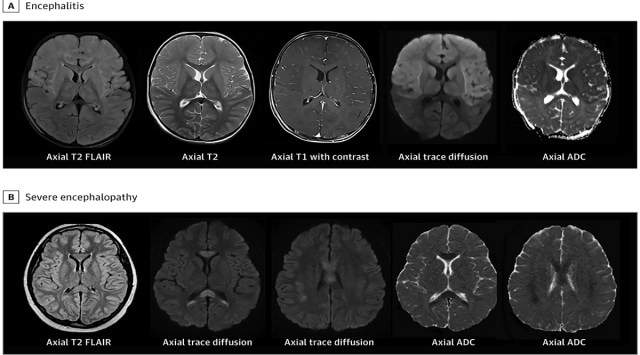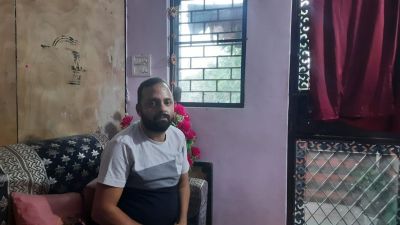- India
- International
Some children with COVID-related syndrome develop neurological symptoms
The condition, called Multisystem Inflammatory Syndrome in Children (MIS-C), typically emerges two to six weeks after a COVID infection, often one that produces only mild symptoms or none at all. The syndrome is rare, but can be very serious.
 A photo provided by LaRovere et al., JAMA Neurolology 2021 shows CT scans of the brain of a previously healthy toddler with Multisystem Inflammatory Syndrome, top; and those of a school-aged child with the condition, bottom, from a study published last month in JAMA Neurology. (LaRovere et al., JAMA Neurolology 2021 via The New York Times)
A photo provided by LaRovere et al., JAMA Neurolology 2021 shows CT scans of the brain of a previously healthy toddler with Multisystem Inflammatory Syndrome, top; and those of a school-aged child with the condition, bottom, from a study published last month in JAMA Neurology. (LaRovere et al., JAMA Neurolology 2021 via The New York Times) Reports about the mysterious COVID-related inflammatory syndrome that afflicts some children and teenagers have mostly focused on physical symptoms: rash, abdominal pain, red eyes and, most seriously, heart problems like low blood pressure, shock and difficulty pumping.
Now, a new report shows that a significant number of young people with the syndrome also develop neurological symptoms, including hallucinations, confusion, speech impairments, and problems with balance and coordination. The study of 46 children treated at one hospital in London found that just over half — 24 — experienced such neurological symptoms, which they had never had before.
Those patients were about twice as likely as those without neurological symptoms to need ventilators because they were “very unwell with systemic shock as part of their hyperinflammatory state,” said an author of the study, Dr. Omar Abdel-Mannan, a clinical research fellow at University College London’s Institute of Neurology. Patients with neurological symptoms were also about twice as likely to require medication to improve the heart’s ability to squeeze, he said.
The condition, called Multisystem Inflammatory Syndrome in Children (MIS-C), typically emerges two to six weeks after a COVID infection, often one that produces only mild symptoms or none at all. The syndrome is rare, but can be very serious. The latest data from the Centers for Disease Control and Prevention reports 3,165 cases in 48 states, Puerto Rico and the District of Columbia, including 36 deaths.
The new findings strengthen the theory that the syndrome is related to a surge of inflammation triggered by an immune response to the virus, Abdel-Mannan said. For the children in the report, the neurological symptoms mostly resolved as the physical symptoms were treated.

Doctors in the United States have also recently reported neurological symptoms in children with MIS-C. In a study published last month in JAMA Neurology, 126 of 616 young people with the syndrome admitted to 61 U.S. hospitals last year had neurological issues, including 20 with what the researchers described as “life-threatening” problems like strokes or “severe encephalopathy.”
The new report, presented as preliminary research Tuesday as part of an annual conference of the American Academy of Neurology, evaluated children under 18 who were admitted to Great Ormond Street Hospital (GOSH) between April and September of last year with the syndrome (it has a different name and acronym, PIMS-TS, in Britain). The data is also included in a preprint of a larger study that has not yet been peer-reviewed.
As was the case with other studies of the syndrome, including in the United States, the researchers said a majority of those afflicted were “nonwhite,” a pattern that public health experts believe reflects the disproportionate way the pandemic has affected communities of color. Nearly two-thirds of the patients were male, and the median age was 10.
All 24 of the patients with neurological symptoms had headaches and 14 had encephalopathy, a general term that can involve confusion, problems with memory or attention and other types of altered mental function. Six of the children were experiencing hallucinations, including “describing people in the room that were not there or seeing cartoons or animals moving on the walls,” Abdel-Mannan said. He said some experienced auditory hallucinations involving “hearing voices of people not present.”
Six of the children had weakness or difficulty controlling muscles used in speech. Four had balance or coordination problems. One child had seizures and three children had peripheral nerve abnormalities including weakness in facial or shoulder muscles. One patient’s peripheral nerve damage led to a foot-drop problem that required the use of crutches and a recommendation for a nerve transplant, said Abdel-Mannan, who is also a senior resident in pediatric neurology at GOSH.
Some of the patients underwent brain scans, nerve conduction tests or electroencephalograms (EEGs), including 14 who showed slower electrical activity in their brains, the study reported.
Thirteen of the 24 with neurological symptoms needed to be placed on ventilators and 15 needed medication to improve their heart contractions, Abdel-Mannan said. By contrast, only three of the 22 children without neurological issues needed ventilators and seven needed such heart medication, he said. None of the children with hallucinations needed psychotropic medications.
Three children had to be hospitalized again after their initial stay, one for another episode of encephalopathy and two for infectious complications, Abdel-Mannan said, but he added that there were no deaths and “almost all children made a complete functional recovery.”
Abdel-Mannan said a team led by the study’s senior author, Dr. Yael Hacohen, will be following patients who had the syndrome — both those who had neurological symptoms and those who did not. They will conduct brain scans and cognitive assessments to see if the children experience any long-term cognitive or psychological effects.
Must Read
Apr 27: Latest News
- 01
- 02
- 03
- 04
- 05








































